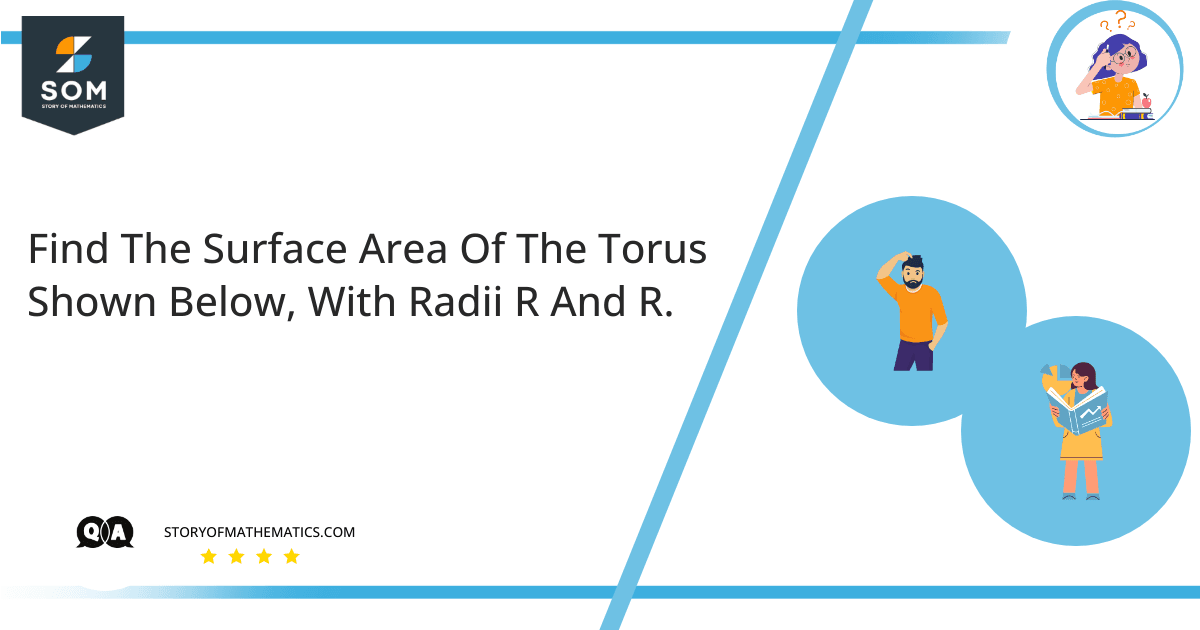
The main objective of this question is to find the surface area of the given torus with the radii represented by r and R.
This question uses the concept of the torus. A torus is basically the surface revolution generated as a result of rotating the circle in the three-dimensional space.
Expert Answer
In this question, we will aim to find the surface area of the torus whose radius of the tube is r and the distance to the center is R.
We know that torus generated as a result of rotating circle is:
\[(x \space – \space R)^2 \space + \space y^2 \space = \space r^2 \space, \space R>r>0 \]
The top half is:
\[f(x) \space = \space (r^2 \space – \space (x \space – \space R^2)^\frac{1}{2} \space, \space R \space – \space r \space\le \space x \space \le \space R \space + \space r\]
Thus:
\[x \space \in [x_0,x_0 \space + \space \Delta x] \]
\[\Delta s \space = \space \sqrt {(\Delta x)^2 \space + \space(f(x_o \space + \space \Delta x) \space – \space f(x_o))^2} \]
\[ds \space = \space \sqrt{1 \space + \space (f’ \space (x))^2}\]
Then:
\[dA \space = \space 2 \pi x d s \space = \space 2 \pi x \sqrt{1 \space + \space (f'(x))^2} dx \]
\[f'(x) \space = \space \frac{1}{2}(r^2 \space – \space (x \space – \space R)^2)^\frac{1}{2} \space 2(R \space – \space x) \]
\[= \space \frac{R \space – \space x}{f(x)} \]
\[= \space \sqrt{1 \space + \space (f'(x))^2} \space = \space \frac{x}{f(x)} \]
Thus:
\[ 2A \space = \space 4 \pi ^2 Rr\]
Numerical Answer:
The surface area of the torus is $ 4 \pi ^2 Rr$.
Example
Find the surface area of the torus whose radii are r and r.
In this question, we will aim to find the surface area of the torus whose radius of the tube is r and the distance to the center r.
Torus generated as a result of rotating circle is:
\[(x \space – \space r)^2 \space + \space y^2 \space = \space r^2 \space, \space r>r>0 \]
The top half is:
\[f(x) \space = \space (r^2 \space – \space (x \space – \space r^2)^\frac{1}{2} \space, \space r \space – \space r \space\le \space x \space \le \space r \space + \space r\]
Thus by simplifying, we get:
\[x \space \in [x_0,x_0 \space + \space \Delta x] \]
\[\Delta s \space = \space \sqrt {(\Delta x)^2 \space + \space(f(x_o \space + \space \Delta x) \space – \space f(x_o))^2} \]
\[ds \space = \space \sqrt{1 \space + \space (f’ \space (x))^2}\]
Then:
\[dA \space = \space 2 \pi x d s \space = \space 2 \pi x \sqrt{1 \space + \space (f'(x))^2} dx \]
\[f'(x) \space = \space \frac{1}{2}(r^2 \space – \space (x \space – \space R)^2)^\frac{1}{2} \space 2(r \space – \space x) \]
\[= \space \frac{r \space – \space x}{f(x)} \]
\[= \space \sqrt{1 \space + \space (f'(x))^2} \space = \space \frac{x}{f(x)} \]
By simplifying we get the surface area of the torus as:
\[ 2A \space = \space 4 \pi ^2 rr\]
Hence, the surface area of the torus is $space 4 \pi ^2 rr$.
